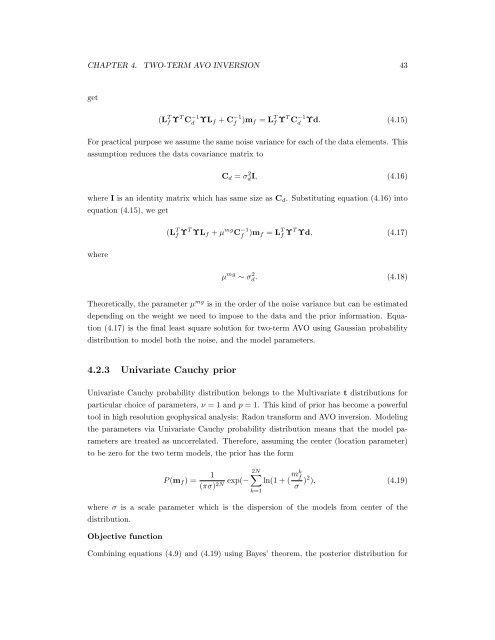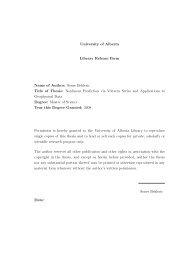Regularization of the AVO inverse problem by means of a ...
Regularization of the AVO inverse problem by means of a ...
Regularization of the AVO inverse problem by means of a ...
You also want an ePaper? Increase the reach of your titles
YUMPU automatically turns print PDFs into web optimized ePapers that Google loves.
CHAPTER 4. TWO-TERM <strong>AVO</strong> INVERSION 43<br />
get<br />
(L T f Υ T C −1<br />
d ΥLf + C −1<br />
f )mf = L T f Υ T C −1<br />
d<br />
Υd. (4.15)<br />
For practical purpose we assume <strong>the</strong> same noise variance for each <strong>of</strong> <strong>the</strong> data elements. This<br />
assumption reduces <strong>the</strong> data covariance matrix to<br />
Cd = σ 2 dI, (4.16)<br />
where I is an identity matrix which has same size as Cd. Substituting equation (4.16) into<br />
equation (4.15), we get<br />
where<br />
(L T f Υ T ΥLf + µ mg C −1<br />
f )mf = L T f Υ T Υd, (4.17)<br />
µ mg ∼ σ 2 d. (4.18)<br />
Theoretically, <strong>the</strong> parameter µ mg is in <strong>the</strong> order <strong>of</strong> <strong>the</strong> noise variance but can be estimated<br />
depending on <strong>the</strong> weight we need to impose to <strong>the</strong> data and <strong>the</strong> prior information. Equa-<br />
tion (4.17) is <strong>the</strong> final least square solution for two-term <strong>AVO</strong> using Gaussian probability<br />
distribution to model both <strong>the</strong> noise, and <strong>the</strong> model parameters.<br />
4.2.3 Univariate Cauchy prior<br />
Univariate Cauchy probability distribution belongs to <strong>the</strong> Multivariate t distributions for<br />
particular choice <strong>of</strong> parameters, ν = 1 and p = 1. This kind <strong>of</strong> prior has become a powerful<br />
tool in high resolution geophysical analysis: Radon transform and <strong>AVO</strong> inversion. Modeling<br />
<strong>the</strong> parameters via Univariate Cauchy probability distribution <strong>means</strong> that <strong>the</strong> model pa-<br />
rameters are treated as uncorrelated. Therefore, assuming <strong>the</strong> center (location parameter)<br />
to be zero for <strong>the</strong> two term models, <strong>the</strong> prior has <strong>the</strong> form<br />
P (mf ) =<br />
1<br />
exp(−<br />
(πσ) 2N<br />
2N<br />
k=1<br />
ln(1 + ( mk f<br />
σ )2 ), (4.19)<br />
where σ is a scale parameter which is <strong>the</strong> dispersion <strong>of</strong> <strong>the</strong> models from center <strong>of</strong> <strong>the</strong><br />
distribution.<br />
Objective function<br />
Combining equations (4.9) and (4.19) using Bayes’ <strong>the</strong>orem, <strong>the</strong> posterior distribution for









